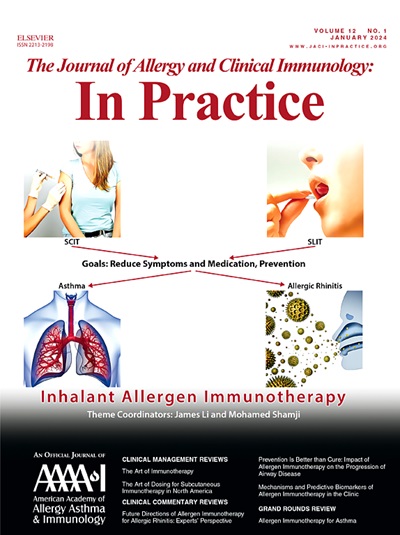儿童食物蛋白性小肠结肠炎综合征(FPIES)复发的严重程度趋势。
IF 8.2
1区 医学
Q1 ALLERGY
Journal of Allergy and Clinical Immunology-In Practice
Pub Date : 2025-04-01
DOI:10.1016/j.jaip.2025.01.011
引用次数: 0
摘要
背景:在存在口腔食物挑战(OFC)的医院中,对食物蛋白性小肠结肠炎综合征(FPIES)患儿重新引入违规食物,导致等待时间过长,增加了医疗成本和人力资源的社会负担。目的:本研究的目的是评估同一患者急性FPIES不良反应随时间的严重趋势,以排除门诊或家庭重新引入不良食物的可能性。方法:所有儿童(结果:202例入组患者中,23例(11.4%)出现从轻中度到重度发作的加重。在这些患者中分析的变量(性别、发病年龄和首次与严重发作之间的间隔)对更严重反应的风险没有统计学意义上的显著影响。所有患者最初表现为轻度或中度发作,随着时间的推移,分别有15.2%和13.9%的患者后来表现为严重发作。牛奶类FPIES患者开始时为轻度发作,5.5%后来出现严重发作。结论:由于发生严重不良反应的概率为0.5%,在家中对急性FPIES进行OFC治疗不够安全。然而,如果有快速转到急诊科的计划,可以考虑在门诊对牛奶类FPIES患者进行OFC。本文章由计算机程序翻译,如有差异,请以英文原文为准。
Severity Trend of Recurrence in Pediatric Food Protein-Induced Enterocolitis Syndrome
Background
Reintroduction of the offending food in pediatric patients affected by food protein-induced enterocolitis syndrome (FPIES) is carried out in hospitals with an oral food challenge (OFC), which leads to a long waiting time and increases the societal burden of medical cost and human resources.
Objective
To assess the severity trend of acute FPIES adverse reactions over time in the same patient for possible outpatient or home reintroduction of the offending food.
Methods
All children (aged <18 years) with a diagnosis of acute FPIES referred to two Italian pediatric allergy clinics were retrospectively enrolled. To determine whether home or outpatient clinic reintroduction of trigger food was possible, a risk of severe reactions of 5% or less was arbitrarily considered acceptable.
Results
Of202 patients enrolled, 23 (11.4%) had increasing severity from mild to moderate up to severe episodes. No variables analyzed in these patients (sex, age at onset, and the interval between the first and severe episodes) had a statistically significant influence on the risk of more severe reactions. Of all patients who initially presented with mild or moderate episodes, 15.2% and 13.9% later manifested severe episodes over time, respectively. Of patients with cow's milk FPIES that started with a mild episode, 5.5% later experienced a severe episode.
Conclusions
Performing OFC for acute FPIES is not safe enough at home because the probability of severe adverse reaction is greater than 5%. However, it could be considered to perform OFC in an outpatient clinic in patients with cow's milk FPIES who started with a mild episode and if a rapid transfer plan to emergency department is available.
求助全文
通过发布文献求助,成功后即可免费获取论文全文。
去求助
来源期刊

Journal of Allergy and Clinical Immunology-In Practice
ALLERGYIMMUNOLOGY-IMMUNOLOGY
CiteScore
11.10
自引率
9.60%
发文量
683
审稿时长
50 days
期刊介绍:
JACI: In Practice is an official publication of the American Academy of Allergy, Asthma & Immunology (AAAAI). It is a companion title to The Journal of Allergy and Clinical Immunology, and it aims to provide timely clinical papers, case reports, and management recommendations to clinical allergists and other physicians dealing with allergic and immunologic diseases in their practice. The mission of JACI: In Practice is to offer valid and impactful information that supports evidence-based clinical decisions in the diagnosis and management of asthma, allergies, immunologic conditions, and related diseases.
This journal publishes articles on various conditions treated by allergist-immunologists, including food allergy, respiratory disorders (such as asthma, rhinitis, nasal polyps, sinusitis, cough, ABPA, and hypersensitivity pneumonitis), drug allergy, insect sting allergy, anaphylaxis, dermatologic disorders (such as atopic dermatitis, contact dermatitis, urticaria, angioedema, and HAE), immunodeficiency, autoinflammatory syndromes, eosinophilic disorders, and mast cell disorders.
The focus of the journal is on providing cutting-edge clinical information that practitioners can use in their everyday practice or to acquire new knowledge and skills for the benefit of their patients. However, mechanistic or translational studies without immediate or near future clinical relevance, as well as animal studies, are not within the scope of the journal.
 求助内容:
求助内容: 应助结果提醒方式:
应助结果提醒方式:


